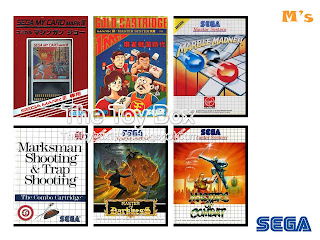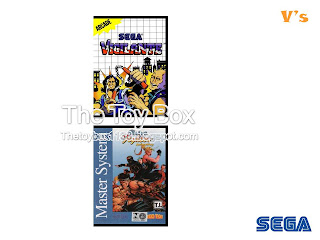
The Sega Master System first debuted in 1985 in Japan, and later in North America (1986) and Europe (1987). It was to be come the first contender to step in the ring with Nintendo for dominance during the home console war.
Unlike the Nintendo Entertainment System, the Sega Master System could play two types of games; cartridge based, and thin "credit card" based. The thinner "credit card" based games were generally cheaper at retail, but were also typically simpler designed games due to the inability to store a high capacity of information. The system was also compatible with a light gun, and featured 3D glasses for use with specifically coded games.
Probably one of the most unique things about the Master System was that the console itself contained games that were built into the system - known as BIOS. These games could be played when a cartridge or card was not inserted into the system. Depending on what model of the console you bought would determine what games were built in.
The system found the most success in Europe where it actually beat Nintendo as the highest selling console. However it failed to nick the surface in Japan and the USA. This was in part because of the monopoly that Nintendo was hard at work creating. In its contracts, Nintendo forced third party game developers to produce games exclusively for their system, and levied heavy fines against any who tried to stray from this. Out of this fear to breach contracts, and lose any potential status with Nintendo, Sega was left picking the scraps up from designers and developers who could get, or didn't want to be in with Nintendo. As a result, there are a larger majority of what gamers consider to be "poor" games for the Sega Master System as compared to the Nintendo Entertainment System.
However, this was not the whole reason why the system failed in the USA. The majority of the blame falls on Tonka who was licensed to market the system in America. As a toy manufacturer, Tonka reps had no experience in marketing video game consoles, and as a result they did so very poorly. With displeasure in Tonka, when it came time to release their follow up console, the Sega Genesis, Sega took matters into their own hands, and marketed the system themselves.
There were also far less games for the system. While Nintendo had almost (if not more than) a thousand games, the Sega Master System's catalog is only a few hundred. Considering how strong the system sold in Europe from 1987-1996, that's not a whole lot of games produced when compared to the time frame. It didn't help that months would go by without any major releases from developers.
While over the course of its time the Sega Master System saw many console variants such as the Mark III, Master System II, and Master System 3, the most notable is the 2006 handheld version which was distributed in the USA by Coleco. It didn't necessarily make the games better, but had a strong nostalgic following.
In 2009, the Master System was voted as the 20th best console (out of 25) - Quiet a slap in the face considering that the prior generation consoles Intellivision ranked in at number fourteen, the Colecovision ranked in at number twelve, and Atari 2600 came in at number two. We'll let you guess who number one was on that list.
Now join us as we take a look at every single game produced for the Sega Master System;

































































Yes, the Sega Master System lost the fight, but for what its worth, it stands as the first true challenger to Nintendo, and with the release of their next console, the lines in the sand was drawn even wider, and while the war had started, a true battle was on the horizon.
Join us next time when we take a look at The Adventures of Batman and Robin!
Click "HERE" to go back to the home page. For more posts related to this one, please click the labels below.

The Master System was very popular in Brazil, where it was built locally. There were some games that were released in Portuguese, and some were even re-made to replace the character of the game by Monica from "Monica's Gang" a popular comic book in Brazil (one such games was Mônica no Castelo do Dragão which was basically Wonder Boy in Monster Land with the main character changed).
ReplyDeleteEven today you can find licence built Master Systems in Brazil in different versions, like a pink one "for girls" or one built into a TV set. Several Brazil current versions have several dozen games in their BIOS.
Thanks for sharing that info.
Delete